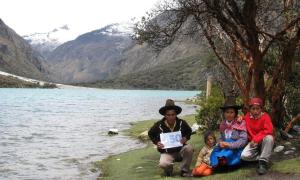For mining projects, identifying indigeneity has become increasingly important due to the system of frameworks that require specific procedures to be undertaken by companies and governments when impacting indigenous communities. This short article discusses the complexity of identifying indigeneity itself, with a focus on Peru.
Identifying indigenous communities is widely recognised as a difficult and indeed contentious task (Kuper 2003). This is perhaps even more so in Peru due to a variety of historical and cultural factors. Peru has widely been noted academically as ‘un país sin indígenas’ (a country without indigenous peoples). This statement is intended whimsically, in response to the absence of an indigenous movement in a demographically indigenous country (45%), which is in striking contrast to its Ecuadorian and Bolivian counterparts (Morrissey 2009, 496; Greene 2006, 333).
The terms Indian (indio) and indigenous (indígena) in Peru have specific cultural meanings, which put simply, are ethnic slurs. While it is not my purpose to fully consider the complexities of ethnic classification in Peru, it is important to note that the relationship between Indian and mixed (mestizo) is widely regarded as a fluid continuum that is not so much concerned with race as it is with ‘development’ (Jackson and Warren 2005, 561; García 2005, 8–9; Starn 1991, 70). In her study of Peruvian ethnic identities, De la Cadena notes that within Peruvian ethnic identity construction, individuals become ‘de-indianised’ through a process of literacy and urbanisation, aptly described in a traditional saying ‘a literate Indian is a lost Indian’ (De la Cadena 2010, 346; De la Cadena 2000, 310) . Ultimately, being mestizo does not necessarily mean erasing indigenous cultural identity (García 2005, 9).
The self-identification of communities as ‘campesinos’ (peasants) can point to indigeneity. The term campesino came to be applied legally to rural indigenous communities in 1969 under the Agrarian Reform Law. This law, and the reforms that followed it, were designed to redistribute the land to the communities who had worked the land under the hacienda system of governance (Coxshall 2010, 41; Cleary and Steigenga 2004, 52; Stocks 2005, 95; Kamphuis 2011, 5–6). Campesino communities are typified by their subsistence farming, culturally distinct cultural practices and institutions (such as rondas campesinas – peasant rounds), in addition to communal land holding practices. Thus, campesino communities are recognised under Peruvian law as having the same rights as indigenous peoples (International Labour Office, n.d; Fulmer 2010, 6).
The importance of the role of NGOs in the construction of indigeneity should be considered. While this subject is certainly contentious academically and has been disregarded by the company , it is impossible to ignore the fact the NGOs have consistently acted as key actors in the indigenous movement over the last twenty years. Lucero argues that NGOs such as Oxfam, “legitimising certain identities and de-legitimising other (Lucero 2011, 2). With the continued support of international NGOs, the demands of local actors have increasingly been articulated in terms of indigenous rights frameworks (Lucero 2011; Sandt 2010, 33; Coxshall 2010, 44). Regardless of whether or not the communities in question are considered ‘indigenous’ by the national government or the company, it appears that they are recognised as such on an international stage. As a result, it is likely that this motivator of the conflict will remain, based on continued support and interest by international NGOs.
That ‘indigeneity’ is a complex and ambiguously defined identity demonstrates the need for a solid ethnographic understanding of communities prior to undertaking extractive projects.
Bibliography
De la Cadena, Marisol. 2000. Indigenous Mestizos, De-Indianisation, and Discrimination. In Indigenous Mestizos: the politics of race and culture in Cusco Peru, 1919-1991, 307-330. London: Duke University Press.
———. 2010. “Indigenous Cosmopolitics in the Andes: Conceptual Reflections beyond ‘Politics’.” Cultural Anthropology 25 (2) (May 1): 334-370. doi:10.1111/j.1548-1360.2010.01061.x.
Cleary, Edward L., and Timothy J. Steigenga. 2004. New voice in religion and politics in Bolivia and Peru. In Resurgent voices in Latin America: indigenous peoples, political mobilization, and religious change, 43-65. Rutgers University Press.
Coxshall, Wendy. 2010. “When They Came to Take Our Resources: Mining Conflicts in Peru and Their Complexity.” Social Analysis 54 (1): 35-51. doi:10.3167/sa.2010.540103.
Fulmer, Amanda. 2010. Consultation and its Discontents: Mining, Indigenous Communities and Rights in Peru and Guatemala. In Toronto.
García, María Elena. 2005. Making indigenous citizens: identities, education, and multicultural development in Peru. Stanford University Press.
Greene, Shane. 2006. “Getting Over the Andes: The Geo-Eco-Politics of Indigenous Movements in Peru’s Twenty-First Century Inca Empire.” Journal of Latin American Studies 38 (02): 327-354. doi:10.1017/S0022216X06000733.
International Labour Office. Peru – Latin America – Activities by region.
Jackson, Jean E., and Kay B. Warren. 2005. “INDIGENOUS MOVEMENTS IN LATIN AMERICA, 1992–2004: Controversies, Ironies, New Directions.” Annual Review of Anthropology 34 (October): 549-573.
Kamphuis, Charis. 2011. “The Convergence of Public and Corporate Power: Yanacocha Mine, Campesino Dispossession, Privatized Coercion.” SSRN eLibrary.
Kuper, Adam. 2003. “The return of the native.” Current anthropology 44 (3): 389-402.
Lucero, Jose. 2011. Seeing Like a NGO: Encountering Development and Indigenous Politics in the Andes. In Tulane University, New Orleans, April.
Morrissey, Laura. 2009. “The Rise of Ethnic Politics: Indigenous movements in the Andean region.” Development 52 (4): 496-499.
Sandt, Joris J. 2010. Legal strategies dealing with negative consequences of extractive projects in Latin America. Cordaid.
Starn, Orin. 1991. “Missing the Revolution: Anthropologists and the War in Peru.” Cultural Anthropology 6 (1) (February 1): 63-91.
Stocks, Anthony. 2005. “TOO MUCH FOR TOO FEW: Problems of Indigenous Land Rights in Latin America.” Annual Review of Anthropology 34 (October): 85-104. doi:10.1146/annurev.anthro.33.070203.143844.

